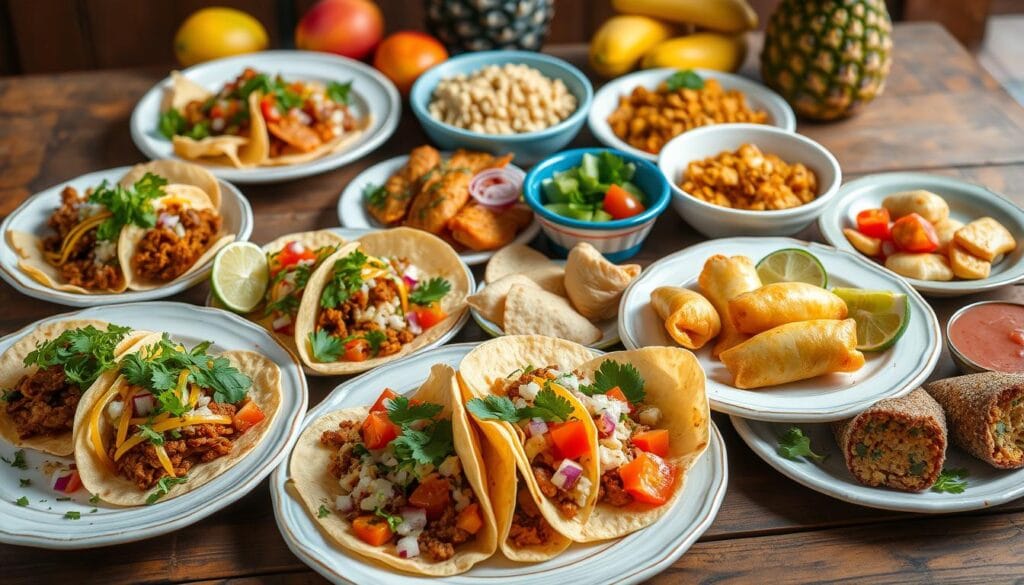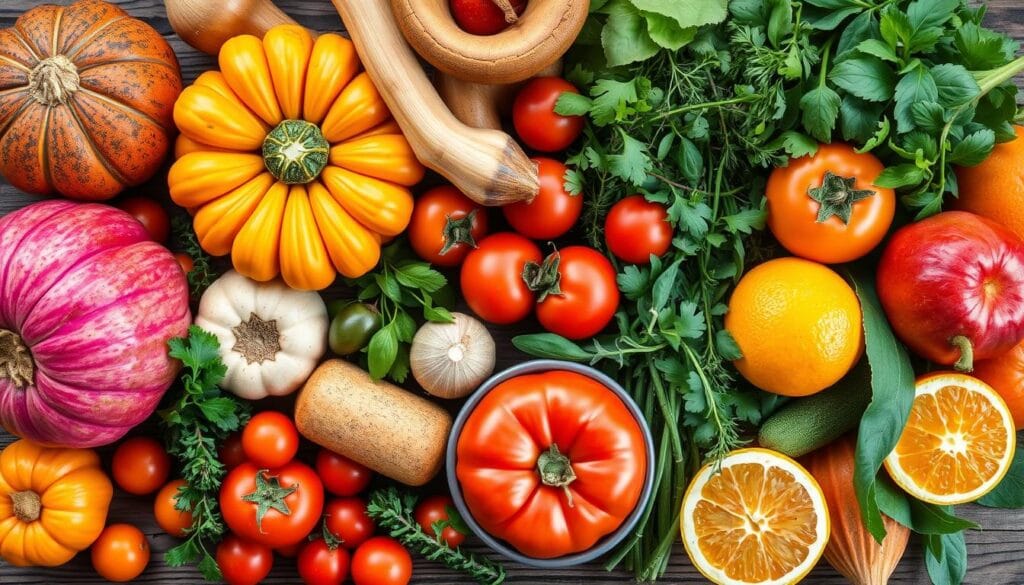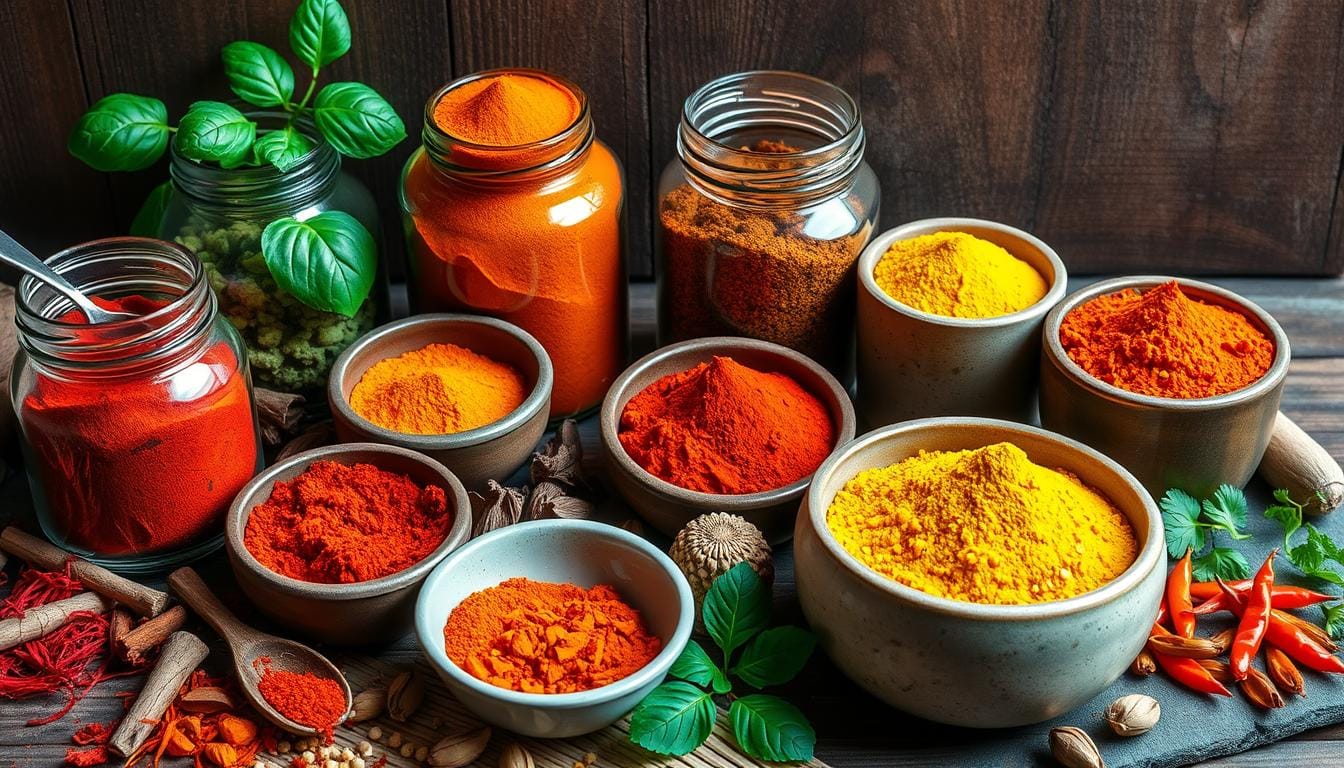Standing in the bustling spice market, the air is filled with exotic scents that highlight the diversity of world flavors. It’s more than a food journey; it’s a dive into the world’s diverse cultures. Each spice, like India’s cardamom or Mexico’s chili peppers, shares a story of global creativity.
Exploring world flavors is like finding a treasure trove of tastes. It lets us see the heart of different cultures through their food. From Japan’s soy sauce to the Middle East’s herbs, each dish opens a window to a community’s soul.
Understanding Global Cuisine’s Rising Popularity
The world of multicultural cooking is booming, with more people wanting to try different flavors. The global flavors market is expected to grow by 7.2% each year until 2025. This shows a big change in what people want to eat.
Market Growth and Consumer Trends
Research shows that 66% of people enjoy trying foods from around the world. Millennials, aged 28 to 43, are especially eager to try new foods at 75%. Cities are now filled with over 30 types of global cuisine, meeting the varied tastes of their people.
The Millennial Impact on Food Diversity
Millennials are leading the way in exploring global cuisine. They look for high-quality food experiences and love authentic Vietnamese, Indian, and Cuban dishes. This shows their adventurous spirit and desire to learn about different cultures through food.
Urban Culinary Landscapes
In the last decade, demand for ethnic foods has grown by 20%. This highlights the growing interest in multicultural cooking. Cities are becoming places where different flavors come together, catering to the changing tastes of their people.
| Generation | Culinary Preferences |
|---|---|
| Gen Z | Projected to be the biggest food service spenders by 2030 |
| Millennials | Constantly seeking new and premium culinary experiences, partial to authentic Vietnamese, Indian, and Cuban dishes |
| Gen X | Has the most spending power on food among generations, attracted to authentic Thai twists on familiar American dishes |
| Baby Boomers | Appreciate traditional Italian, Chinese, and Mexican cuisine, but are open to global mashups and twists on their favorite dishes |
The rise of multicultural cooking shows a big cultural shift. People of all ages are eager to try new foods and learn about global cuisines.
The Journey Through Traditional World Flavors
Traditional dishes are key to keeping cultural heritage alive. They show a country’s history and traditions through taste. Countries like Italy, Japan, and France have dishes that are famous worldwide. These dishes use local ingredients and cooking methods, showing a culture’s values and history.
Italy’s pizza is loved everywhere, showing Italy’s love for fresh ingredients. France’s baguette was added to UNESCO’s list in 2022, showing its importance. Japan’s sushi is famous for its balance of flavors and art.
Spices like cinnamon and cloves are big in Europe, thanks to trade. Chinese stir-frying and soy sauce are now common in Western cooking. Turmeric, known for its taste and health benefits, is used worldwide.
| Dish | Region | Key Characteristics |
|---|---|---|
| Pizza | Italy | Globally recognized, made with fresh, flavorful ingredients |
| Baguette | France | Inscribed on UNESCO’s Intangible Cultural Heritage list in 2022 |
| Sushi | Japan | Significant culinary export, showcasing Japan’s culinary expertise |
These dishes show how food can bring people together. As the world gets closer, we keep exploring and loving traditional flavors.
“Food is not just about sustenance, but also about culture, tradition, and the stories they tell.”
Cultural Heritage Through National Dishes
Culinary traditions are key to our cultural identity. They show our history, local ingredients, and unique tastes. UNESCO highlights many dishes as part of our cultural heritage. These dishes help keep our national cuisines alive.
UNESCO-Recognized Culinary Traditions
In South Korea, kimchi is made with care and shared with others. In Turkey, keşkek is a big deal. UNESCO lists these traditions to show their cultural value. In 2022, Ukraine’s borscht was added, showing the importance of these dishes.
Signature Dishes by Region
- Italy’s pizza, Japan’s sushi, and France’s baguette are iconic national dishes that represent the culinary essence of their countries.
- Traditional ingredients in Mexican cuisine, like maize and chili peppers, reflect the region’s agricultural history and pre-Hispanic civilizations’ culinary influences.
- Sushi in Japan symbolizes a deep respect for nature, flavor mastery, and precision, while Día de los Muertos in Mexico features family-prepared dishes like pan de muerto.
Preserving Cultural Identity
Traditional recipes connect people to their heritage, even when they move. They help people feel at home in new places. Efforts to revive old cooking traditions are underway. This includes using wild rice, bison, and native corn.
By celebrating the origins of these dishes, we keep their true spirit alive. This way, we avoid making foreign foods seem exotic.
“The more often individuals share food with others, the more likely they are to feel content and satisfied with their lives.”
– University of Oxford research
The Art of Spice: Global Seasoning Traditions
Spices have deeply influenced cuisines worldwide, creating unique flavors and traditions. Cinnamon, nutmeg, and cloves changed European cooking. Meanwhile, turmeric is loved for its taste and health perks. These global spices are a big part of our cooking history.
The Spice Routes linked far-off places, bringing new exotic ingredients to kitchens. These global spices changed cooking and food saving. They also led to exciting fusion dishes that mix cultures.
“Spices were used not only for flavor but also for their medicinal properties, illustrating the diverse roles spices played in different cultures.”
Cumin adds earthy taste, while coriander brings citrusy sweetness. Basil and oregano mix well, creating a peppery flavor. Blending these global spices is an art that needs both feeling and trying.
The spice trade started around 2000 BC and has greatly influenced food, economies, and world power. The search for rare global spices like cinnamon, nutmeg, and cloves led to new discoveries and trade paths. This changed history forever.
Today, these global spices still inspire chefs and home cooks. They explore endless flavor mixes and discover the rich culinary traditions from around the world.
Mediterranean Cuisine: A Health-Conscious Journey
Mediterranean cuisine is becoming more popular in the United States. It focuses on heart-healthy olive oils, fresh ingredients, and lean proteins. This makes it a great choice for those looking for a healthy meal.
Olive Oil and Fresh Ingredients
Olive oil is at the core of Mediterranean cooking. It adds flavor and health benefits to dishes. The best olive oils come from autumn harvests, making each dish fresh and full of flavor.
Regional Cooking Methods
Mediterranean cuisine is known for its diverse cooking methods. From Greece’s grills to Italy’s slow-roasted meats, each region has its own way of cooking. This variety creates a rich tapestry of flavors.
Seasonal Mediterranean Dishes
The Mediterranean diet celebrates the seasons. Chefs and home cooks use the freshest ingredients all year. This approach brings vibrant dishes like ratatouille and hearty lamb stew to the table.
Mediterranean cuisine is loved for its focus on healthy ingredients and traditional cooking. Exploring Greece, Morocco, or Italy through this diet is a tasty and healthy adventure.
Asian Culinary Mastery: From Sushi to Stir-Fry
Asian cuisine is a world of flavors, from Japanese miso to Thai curries. It has a history of over 3,000 years. Chinese stir-frying techniques spread to the West, changing global food.
Soy sauce, used for over 2,500 years, adds umami to dishes. It’s loved worldwide for its flavor. Tofu, a soy-based food, is also popular, fitting many diets.
Sushi, a key Asian dish, has won hearts globally. People love to make it at home. It requires skill in knife work, fish choice, and rice making.
Asian and Western flavors are now blending, creating new dishes. These dishes mix old Asian ingredients with new cooking methods. They show the creativity of Asian cooking.
“Sushi is more than just a dish; it’s a work of art that requires meticulous attention to detail and a deep appreciation for the ingredients.”
Enjoying sushi or stir-fry is a culinary adventure. It’s a journey that excites food lovers everywhere.
Latin American Flavors: Bold and Vibrant
Start a flavorful journey through Latin American cuisine. You’ll find zesty Mexican tacos and fragrant Peruvian quinoa salads. This region’s food is a mix of indigenous ingredients and old cooking ways.
Traditional Cooking Techniques
Latin American cooking is all about old methods passed down. Slow-roasting, wood-fire grilling, and special seasoning blends add depth to dishes. Learning to make enchiladas, Chilean cazuela, and Peruvian ceviche will show you the region’s food culture.
Indigenous Ingredients
Latin American flavors come from native ingredients. Corn, beans, peppers, and tropical fruits are key. Using these in your cooking can take you straight to Latin America.
Festival Foods and Celebrations
Food is a big part of Latin American culture. It’s seen in the region’s lively festivals and gatherings. From Mexico’s street food to Brazil’s desserts, these foods show the area’s diversity and creativity. Hosting a Latin-themed dinner or adding Latin flavors to your cooking is a fun way to dive into this tradition.
Explore the bold and exciting flavors of Latin American cuisine. Here, traditional methods, native ingredients, and festive dishes come together for a memorable food experience.

“Latin American cuisine is a tapestry of vibrant flavors, woven together by the rich cultural heritage and diverse culinary traditions of the region.”
Modern Fusion: Where Traditions Meet Innovation
Fusion food is a big trend now, mixing the best of world cuisines. Chefs are trying new things, combining flavors in exciting ways. They’re bringing together different cooking traditions in bold ways.
Jaks Authentic Indian & Modern Vibe in Santa Clara is a great example. Chef Prakash Singh’s menu combines old traditions with new twists. He draws from all over India, making a menu that celebrates the country’s rich food history.
At Jaks, you can try dishes like Banarasi Paan Patta and Marwari Paneer Tikka. There’s also Karikudi Chicken Fry and Pistachio Burra Chaap. Each dish shows Chef Singh’s skill in mixing old cooking methods with modern flavors.
Fusion food isn’t just about Indian dishes. Chefs everywhere are rethinking traditional recipes. In Isan, Thailand, places like Samuay & Sons and Kaen mix French and Thai flavors with Japanese precision.
In Isan, chefs use local ingredients and focus on the beauty of nature. This mix of old and new has made Isan famous for food lovers worldwide.
Our world is getting more connected, leading to new fusions in food and fashion. Japanese and Mexican flavors meet in dishes, and old textiles get a modern twist. This blending of ideas is changing how we create and express ourselves.
| Fusion Dish | Inspiration |
|---|---|
| Sushi Burrito | Japanese and Mexican |
| Korean Taco | Korean and Mexican |
| Kimchi Quesadilla | Korean and Mexican |
| Matcha Tiramisu | Japanese and Italian |
| Pho-spiced Beef Wellington | Vietnamese and French |
“Fusion cuisine blends culinary traditions from different cultures, creating exciting new flavors and dishes. Chefs experiment with unexpected pairings, resulting in unique creations that push the boundaries of traditional cooking while honoring culinary heritage.”
The Role of Seasonal Ingredients in World Flavors
Seasonal ingredients are key in shaping local cuisines. They ensure dishes are fresh, flavorful, and nutritious. Traditional dishes often rely on what’s locally available.
As harvests change, so do the dishes and preserves. Chefs create new recipes with what’s in season. This leads to menus that change with the seasons, celebrating each time’s bounty.
Local Produce Impact
At Elements of Chapel Hill, they source from local farms like Heritage Farms in Seven Springs, NC. They also get items from Homeland Creamery in Julian, NC, and East Branch Ginger in Pittsboro, NC. This shows their commitment to seasonal ingredients and sustainable cuisine.
Harvest Cycles and Cuisine
Eating at Elements of Chapel Hill supports the community and the environment. Their focus on quality and sustainability makes them stand out. Chefs use the seasonal harvest to create unique dishes.
Each visit is a memorable experience. It celebrates the best of each season.
Sustainability in Global Cooking
Eating seasonal ingredients can make fruits and veggies 20-40% more nutritious. They also have 15-25% more antioxidants and vitamins. Plus, they last 10-30% longer, reducing waste and using resources wisely.
Choosing seasonal, sustainable cuisine can cut carbon emissions by 10-20%. It also supports local, eco-friendly farming.

“Showcasing a dynamic menu experience, Elements of Chapel Hill’s chefs draw inspiration from the seasonal harvest to create innovative and exciting dishes. This approach ensures that each visit offers a unique culinary experience that celebrates the best of each season.”
Street Food Culture Across Continents
Street food brings people together with its shared flavors. In markets and city corners, vendors offer quick, tasty bites. These dishes, like tacos in Mexico and spring rolls in Vietnam, show the rich tastes of the world.
These dishes offer real flavors, often telling a region’s story. Street food has become more popular, even earning Michelin stars. Chefs now mix street food with fancy dishes.
Social media has made street food famous, turning vendors into stars. Instagram and TikTok show street food to thousands. Now, street food includes healthy and eco-friendly options for today’s food lovers.
In places like Singapore, hawker centers offer many authentic dishes. They show how tradition meets modern in street food.
| Region | Popular Street Food Dishes |
|---|---|
| Asia | Takoyaki, Okonomiyaki, Yakitori (Japan), Jianbing, Roujiamo, Baozi (China), Pad Thai, Som Tam, Mango Sticky Rice (Thailand), Chaat, Vada Pav, Pav Bhaji (India) |
| Latin America | Coxinha, Pão de Queijo, Churros (Brazil), Ceviche, Anticuchos, Salchipapas (Peru), Choripán, Empanadas, Asado (Argentina) |
| Africa | Tagine, Harira, B’stilla (Morocco), Suya, Puff-Puff, Akara (Nigeria), Injera, Shiro, Kitfo (Ethiopia) |
| Europe | Pizza al Taglio, Arancini, Panini (Italy), Crepes, Quiches, Croissants (France), Patatas Bravas, Tortilla, Churros (Spain), Currywurst, Doner Kebab, Pretzels (Germany) |
| North America | Hot Dogs, Burgers (United States) |
The global street food scene keeps growing. It mixes old recipes with new flavors, celebrating the culinary diversity of the world.
“Street food is the heartbeat of a city, where flavors and cultures collide to create something truly unforgettable.”
Global Food Markets and Ingredient Sourcing
The world is getting more connected, and so is the food market. Now, chefs and home cooks can use international ingredients like exotic spices and produce. This culinary globalization has made our taste buds more adventurous. It also helps traditional recipes evolve, fitting local tastes and what’s available.
Food markets around the world are key in getting international ingredients. They help share flavors and cooking methods. Whether it’s a small shop or a big market, these places open doors to new tastes. They connect people with a wide range of flavors.
| Emerging Trends in the Global Food Flavors Industry | Impact |
|---|---|
| Increased demand for plant-based and natural flavors | Reflects health-conscious consumer preferences for clean, sustainable ingredients |
| Rising interest in exotic and ethnic flavors | Caters to diversifying culinary preferences and embraces multicultural tastes |
| Expansion of flavor customization options | Enables personalization and tailored flavor profiles for consumers |
| Innovation in flavor encapsulation technologies | Enhances flavor stability, masking, and shelf life in food products |
| Emphasis on sustainability in ingredient sourcing | Addresses consumer demand for ethically sourced, environmentally conscious ingredients |
The global food flavors market is changing fast. It’s because of new tastes and tech. The role of international ingredients in culinary globalization will grow even more important.
“The world’s cuisines are converging, and consumers are eager to explore new flavor profiles and cooking techniques from around the globe.”
Conclusion
Exploring the world of flavors is a fun journey through different culinary traditions. It helps us understand and appreciate cultures. The world of food keeps changing, thanks to migration, fusion, and social media.
By trying new foods, we can learn about cultures and connect with places far away. Food is a universal language that brings us together.
The flavors of the world are rich and varied. From sour and spicy tamarind to the sweet and spicy of Thai dishes, there’s so much to discover. Exploring these flavors opens our eyes to new tastes and ways of cooking.
It’s exciting to see how different places shape their food. Northern and Southern Italian cuisines, for example, have unique flavors. Southeast Asian dishes rely on herbs and spices for their taste.
The world of flavors is endless, filled with cultural heritage and creativity. It’s a chance to explore and learn. Let’s dive into this journey and discover new tastes together.
Frequently Asked Questions
How many flavors are there in the world?
There are many flavors in the world, typically categorized into five basic tastes: sweet, salty, sour, bitter, and umami. However, each culture and cuisine brings unique variations and combinations, making the world of flavors incredibly diverse.
What is the world’s most popular flavor?
Sweet is often considered the most popular flavor globally, as it’s found in many beloved foods, from fruits and desserts to beverages. However, preferences can vary greatly depending on cultural influences and regional tastes.
What is the globalization of flavors?
The globalization of flavors refers to the spreading and fusion of different culinary traditions across borders. This phenomenon allows people around the world to enjoy and experiment with international ingredients, spices, and cooking techniques.
What are the different types of flavors?
The five primary types of flavors are sweet, salty, sour, bitter, and umami. Each flavor category brings a distinct taste to food, and chefs often combine them to create balanced and complex dishes.
What is the most universally liked flavor?
Sweet is considered the most universally liked flavor. Most people have a natural affinity for sweetness, which is why sugary foods and desserts are so popular across cultures.
What is the king of flavor?
Many culinary experts argue that umami, often described as a savory or meaty taste, could be considered the “king of flavor.” It’s a flavor profile found in foods like soy sauce, cheese, and mushrooms, and it’s known for enhancing the overall taste experience.



